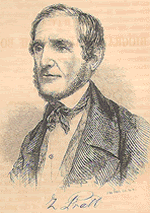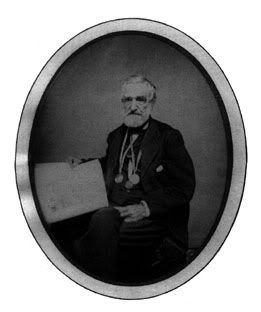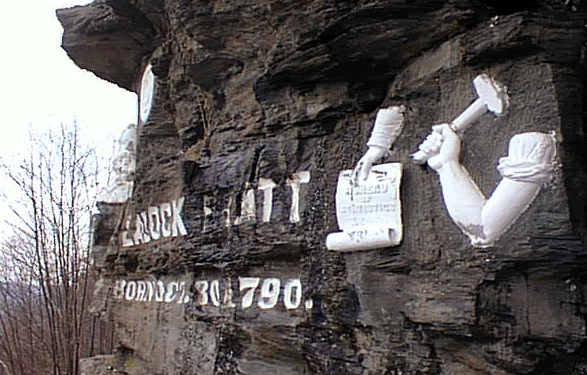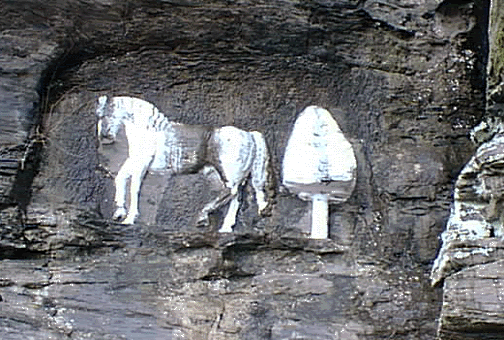

ZADOC PRATT
1790-1871
1790-1871
The life of this gentleman, for many years one of the most prominent manufacturers and Democratic politicians in the State of New York, was, from the commencement of his career, a checkered one. "It exhibits pointed facts and established truths that should be taught to the rising generation. It tells, in a language that they cannot mistake, that labor, perseverance, probity, and integrity will lead to independence and affluence, and gather honors for its votaries. It will show to them that there is but one road to pursue, and that is the path of virtue; that though thorns may peer at first through its narrow opening, yet the path widens as they advance, and flowers bloom to welcome them." Mr. Pratt was born at Stephentown, Rensselaer County, New York, October 30, 1790. His father was a tanner, with limited means, who could afford to give his son but little education. At an early age Zadoc began learning the trade of his father, at Middlebury. During his leisure hours, he braided whip-lashes, the sale of which, after a little time, brought him the amount of thirty dollars, a large sum in those days for a boy to earn in addition to the performance of his regular duties. He was next apprenticed to a saddler, and upon the expiration of his time was employed by his father and brothers. After working for a year as a journeyman saddler, at ten dollars a month, young Pratt commenced business for himself. With an unusually large share of activity and industry, he devoted fifteen or sixteen hours per day to labor. he commenced by keeping an exact account of all business transactions, and continued this systematic course throughout his business life. After a few years spent as a saddler and harness maker, he sold his store and entered into partnership with his
brothers in the tanning business. In 1819 he disposed of his share in the concern, and undertook an adventure for his brothers, to Canada, to traffic in furs. A few years later, Mr. Pratt again recommenced the business of tanning, in a limited way at first, but finally on a grand scale. Up in the Catskill Mountains he established a gigantic tannery, five hundred and fifty feet long, said to be the largest in the world. In about a score of years during which the business was carried on there, a million of sides of sole leather were tanned, and the quality of the work was as admirable as the quantity was great. For bark and wood alone half
a million dollars was paid; and some six millions of dollars expended without a single case of legal litigation. He founded the settlement of Prattsvllle village, building over a hundred houses, besides helping to erect, an academy and several churches. In 1823 Mr. Pratt was elected Colonel of the One Hundredth "Regiment of New York, and made his own military saddle and bridle, which were handsomely ornamented with silver. Mr. Pratt entered into politics as an advocate of Democratic principles, and he remained true to the party to the end of his life. In 1836 he was chosen one of the Presidential Electors. The same year he was elected a "Representative in Congress for the Eighth Congressional District of New York. He made himself familiar with the duties of his office, and labored successfully for the public good. In 1842 he was re-elected. While in Congress he advocated reduction in the rates of postage; his plans for the Post Office buildings, were adopted; he addressed the House of Representatives for the purpose of having constructed a dry dock at Brooklyn ; and was the originator of the Bureau of Statistics. He voted for the first telegraph line from Baltimore to Washington, and advocated the appropriation of ten thousand dollars for surveying the route of a railroad to the Pacific. He held his last official position in 1852, that of a presidential elector. The same year he was a delegate to the Baltimore Convention, and numerous other Democratic conventions. He was president of many societies and institutions. He traveled extensively in his own and foreign countries. His death took place at Bergen, New Jersey, April 6, 1871. "Over eighty years on earth was vouchsafed to Mr. Pratt. In the long evening of his life, honored and respected for his uprightness and integrity by all who knew him; looked up to with veneration and gratitude by the many whom his counsel or charity befriended, the old tanner of the Catskill Mountains must have looked death fearlessly in the face, conscious that he had done his duty in the flesh and had naught to apprehend and everything to hope for in the world to come."
PRATT, Zadock, manufacturer, born in Stephentown, Rensselaer County, New York, 30 October, 1790; died in Bergen, New Jersey, 6 April, 1871. His father, of the same name, had served in the Revolutionary army, and was a tanner and shoemaker. The son was employed in his father's tan-yard, and, while he was a boy, invented an improved pump for raising liquid from the vats, which is still in use. He was apprenticed to a saddler in 1810, began business on his own account a year later, and in 1815 formed partnership with his brothers in the tanning business, in which he was very successful. In 1824 he built what he intended to be the largest tannery in the world, around which grew the present town of Prattsville, New York He was also interested in eleven similar establishments. In 1837 he received from the New York institute the first silver medal that was ever awarded for hemlock sole-leather. He was elected to congress as a Democrat in 1836 and in 1842, serving one term each time. During his congressional career he was active in his efforts for the reduction of postage, established the National bureau of statistics, and as one of the committee oil public buildings advocated the use of granite or marble in their construction, instead of sandstone. The post-office buildings in Washington were erected according to his plans. He was also one of the earliest advocates of a Pacific railroad, and in 1845 offered a resolution for the distribution of engravings of patent devices through the country for the benefit of mechanics and the stimulation of invention. In 1836 and 1852 he was a presidential elector, He founded a bank in Prattsville, and contributed largely toward the growth of that town. Ire was a colonel of militia in 1823, and was generally known by his title.--His son, George Wat-so, , , soldier, born in Prattsville, New York, 18 April, 1830; died near Manassas, Virginia, 21 July, 1861, was educated in Poughkeepsie, New York, and in Europe, receiving the degree of Ph.D. at the University of Erlangen, Bavaria. He engaged in banking, took an active interest in politics, and served in the state senate. At the beginning of the civil war he became colonel of the 20th New York regiment, and at the time of his death, at the battle of Bull Run, he was acting brigadier-general. Colonel Pratt was the author of an elaborate review of General George B. McClellan's report on the Crimean war.
1. Zadock PRATT was born 30 Oct 1790 in Stephentown, Rensselaer Co., New York, the son of Zadock Pratt and Hannah Pickett. He died 5 Apr 1871 in Bergen, Bergen Co., New Jersey and was buried in Prattsville, Greene Co., New York.
Zadock married (1) Beda DICKERMAN on 6 Oct 1817 in Greene Co., New York. Beda was born 17 Nov 1791 in Mt. Carmel, Connecticut. She died 19 Apr 1819 in Lexington, Greene Co., New York.
[Notes]
Zadock also married (2) Esther DICKERMAN on 2 Oct 1821 in Greene Co., New York. Esther was born 22 Aug 1793 in North Haven, Connecticut. She died 22 Apr 1824 in Lexington, Greene Co., New York.
[Notes]
Zadock also married (3) Abigail P. WATSON on 12 Jan 1828 in Greene Co., New York. Abigail was born 1807 in Rensselaerville, Albany Co., New York. She died 5 Feb 1834 in Prattsville, Greene Co., New York.
[Notes]
Zadock and Abigail had the following children:
+ 2 M i George Watson PRATT was born 18 Apr 1830 and died 13 Sep 1862.
+ 3 F ii Julia Harriet PRATT was born 10 Feb 1832 and died 13 Mar 1898.
4 F iii Abigail Watson PRATT was born 24 Jan 1834 in Prattsville, Greene Co., New York. She died 14 May 1834 in Prattsville, Greene Co., New York.[Notes]
Zadock also married (4) Mary E. WATSON on 16 Mar 1835 in Greene Co., New York. Mary was born 1811 in Albany Co., New York. She died 17 Jul 1868 in Providence, Saratoga Co., New York.
[Notes]
Zadock also married (5) Susie GRIMM on 16 Oct 1869 in Prattsville, Greene Co., New York. Susie was born 1842 in Brooklyn, New York. She died after 5 Apr 1871.
2. George Watson PRATT (Zadock ) was born 18 Apr 1830 in Windham, Greene Co., New York. He died 13 Sep 1862 in Albany, Albany Co., New York.
[Notes]
George married Anna Attwood TIBBITS on 31 May 1855 in Albany, Albany Co., New York. Anna was born 6 Sep 1833 in Albany, Albany Co., New York. She died 8 Oct 1921 in Dinard, France.
[Notes]
George and Anna had the following children:
5 M i George Seymour PRATT was born 23 Aug 1856 in or near, Albany, New York. He died 30 May 1866.[Notes]
+ 6 F ii Elizabeth Bleecker Tibbits PRATT was born 27 Jan 1860 and died after 1926.
3. Julia Harriet PRATT (Zadock ) was born 10 Feb 1832 in Prattsville, Greene Co., New York. She died 13 Mar 1898 in New Haven, New Haven Co., Connecticut.
[Notes]
Prattsville, New York
"America's First Mt. Rushmore" was carved into a cliffside south of Prattsville, NY, to please Zadock Pratt, wealthy entrepreneur, congressman and husband of five wives.
Pratt ran the biggest shoe leather tannery in the world and loved to promote himself. The story goes that one day in 1843 a jobless man asked Zadock for a handout. Pratt, who believed in workfare not welfare, asked the man what he did for a living. When the man replied that he was a stonecutter, Zadock pointed to the cliff overlooking his 350-acre farm and told him to start carving Zadock's life story. The luckless laborer didn't stop until Zadock finally died, 28 years later.
The carvings -- which include Zadock, his son, a horse, and a brawny arm holding a sledgehammer -- lack symmetry of the Prez heads in SD, and, your could push 'em all up Lincoln's nostril and still have room. But there is a serpentine path up the hill that allows for close-up inspection and a dizzying view of the Schoharie River below. The path is narrow, steep and crumbly, so it probably isn't a good idea to bring your grandmother here, much as it isn't a good idea to take her to another nearby Catskills attraction that we could name but won't.
Pratt is the Father of the US Bureau of Statistics.
Zadock planned to be buried in a tomb carved into the cliff beneath his own giant head, but it leaked water whenever it rained so the plan was abandoned. The tomb now makes a handy shelter for changing film or camcorder batteries.
Mr. Big Deal Industrialist had to be buried with the common folk in Benhem Cemetery, downtown. However, Pratt Rock is graced with the common grave of six of Zadock's favorite horses and dogs, all lying beneath a big mound marked with a tombstone near the picnic tables.
(Pratt Rock: On Hwy. 23 just south of Prattsville. Look for the green sign with the white horse.)


Pratt Rock
Hon. Zadock Pratt
Retyped from Beers "History of Greene County" by Annette Campbell
Extracts from his chronological biography.
"Zadock Pratt was born at Stephentown, Rensselaer county, New York, October 30th 1790."
"1802---Removed to Windham, since Lexington, now Jewett, Greene county, New York, and there worked at tanning in his father's yard."
"1807---Was one of the passengers on board the Fulton, the first steamboat that navigated the North River."
"1811---October 30, was twenty one years of age. Had $30."
"1812---Commenced business on his own account, at Lexington, in one of the store-houses, working from 14-16 hours a day; keeping a debit and credit account, and each year an inventory, which he has practiced ever since."
"1814---Caused to be made 100,000 oars, and transmitted them to New Tork from the Catskill Mountains."
"1816---Joined the Masonic order at Windham."
"1817---Was married to Miss Beda Dickerman. (She lived 6 months and eleven days.)"
"1820---April 25, unanimimously chosen captain in the 5th Regt., NY S. Artillery, and uniformed the company consisting of 100 men, at his own expense."
"1821---October 2, married Miss Esther Dickerman."
"1823, July 12---was unanimimously elected colonel of the 116th regiment of infantry of the State of New York."
"1824, August 16---was present at the landing of LaFayette and his son in New York; during same year was at the completion of the Erie Canal."
"1824, October---located and began to build on the Schoharie Kill, now Prattsville, carrying all in onehorse wagon, $14,000. He said to the people, "I came to live with them, not on them." November 17, finished the tannery dam and swam it---ice making fast."
"1825, March 14---began to build this great tannery on the banks of the Schoharie Kill. Same year commanded the escort of General LaFayette into Catskill; also laid out the village of Prattsville, gave the turnpike company $150 to improve the turnpike."
"1826---Mansion house built, and the hickory, maple and elm trees planted in front of his house and on each side of the street throughout the village (nearly 1,000, and as many on his farm); same year resigned the office of colonel of 116th regiment to the commander-in-chief, governor of the State of New York."
"1827---was elected supervisor of the town of Windham."
"1829, January 12---married his third wife, Miss Abigail P. Watson (she lived 5 years)."
"1832, November 20th---gave notice that an application would be made to the Legislature of the State of New York, at their next session, to divide the town of Windham."
"1833, March 8th---the town of Prattsville was set off from Windham, with a population of about 1500, and named after the founder."
"1835, March 16th---married his fourth wife, Miss Mary E. Watson, sister of his late consort; same year built a parsonage and carriage-house, and gave a deed to it to the Methodist-Episcopal society, also gave the ground of the Methodist, and paid one-third the expense of both the Dutch Reformed and Methodist churches---gave the bell of the Reformed church."
"1836, March---built a bridge 130 feet long over the Schoharie Kill in 11 days, without the use of ardent spirits---snow 3 feet deep on the level. November same year, was elected a Representative in Congress from the 8th Congressional district, composed of the counties of Greene, Schoharie and Columbia, by over 2,800 majority; was chosen one of the electors of president and vice-president, for the State of New York, met with the electors, and cast his vote for VanBuren and Johnson at Albany."
"December 4th---met at the regular session in Congress."
"1838, March 19th---moved a resolution in favor of the reduction of postage---7 years later had the pleasure of voting the postage down to 5 cents a letter from 25 cents."
"1839, September---was elected member of the American Institute; same year tannery located at West Kill, town of Lexington burnt, loss $10,000, insured for $7,000."
"1842, November 8th---was chosen a Representative in Congress from the 11th Congressional district, New York, composed of Greene and Columbia counties."
"1843, October 30th---established the Prattsville Bank. December 4th, was present at the meeting of the 27th Congress."
"1844---elected president of the Greene County Agricultural Society."
"Moved the survey of railroad route from the Mississippi to the Pacific."
"February 28th---was on board of the Princeton at the time of the explosion of its great gun, in the harbor of Alexandria, when Messrs. Upshur, Gilman, Gardiner, and others were killed, and was the first to aid the wounded."
"May 25th---was appointed on a select committee consisting of Messrs. Winthrop, Pratt, C.J. Ingersoll, Slidell, and Marsh, to report a place for the permanent location of the statue of Washington."
"August 9th---12 M., Windham tannery burnt; loss $12,000, insured for $9,000."
"December 4th---met with Congress."
"1845, February 20th---caused to be put up, the marble jet d'eau fountains in the Capital Square, Washington."
"March 3rd---Congress adjourned sine die; was glad---tired of legislating and doing business with others; in the 5 sessions of Congress was never absent one day."
"June 10th---Grace Church (Episcopal), Gothic architecture, built at Prattsville; was trustee, builder, and vestryman, gave one-third the cost and the land. (During this year had the carvings done on the rocks.) Also closed the Prattsville tannery."
"1847, January---elected an honorary member of the Louisiana State Agricultural and Mechanical Association."
"August 28th---addressed a letter to the people of the United States on the importance of a railroad across the continent to the Pacific Ocean."
"1848---bought the Palen Tannery; remodeled and built the Samsonville Tannery, in partnership with Henry A. Samson, where 60,000 sides of oak leather were tanned yearly."
"July 23rd---received the honorary degree of master of arts from Union College, Schenectady, New York. (This is the first instance in the State of a similar honor being conferred upon a self-taught mechanic.)"
"September 6th---received a respectable vote for governor, at the democratic convention, met at Syracuse, New York. Same year in company with Julius F. and Levi H. Alden, built the Aldenville Tannery at Aldenville, Wayne county, Pennsylvania, where 60,000 sides of leather were tanned yearly with hemlock bark."
"1851, July 8th---appointed a delegate to the World's Fair, by the Mechanic's Institute of the city of New York. Same year was at the celebration and completion of the Erie Railroad."
"1852, January 10th---joined the Tammany Society, at Tammany Hall, New York."
"November 30th---closed the Prattsville Bank."
"1853, June 8th---Windham Tannery burnt at 12 o'clock at noon the second time; loss $12,000, insured for $10,500."
"Same year received a diploma and medal and 3 elegant gilt bound volumes with a likeness of Prince Albert, for six different kinds of sole leather and butts, sent to the World's Fair, London, from as many tanneries, received by letter from Millard Filmore, president of the United States."
"June 7th---Elected president of the Six-Penny Savings Bank in the city of New York, one of the first of it's kind in the State. Gave his son and daughter on their coming of age, each $50,000, and each one-half of a tannery---George, the Samsonville; Julia, the Aldenville."
"1854---Appointed by the Legislature of the State of New York, director in the United States Inebriate Asylum."
"March 31---Saw Estrampes garrotted at Havana for high treason."
"1857---Elected a member of the Geographical and Statistical Society of New York City."
"1858---Received an honorary diploma from the New York State Agricultural Society for the best dairy farm---365 acres---keeping 50 cows."
"1861---Gave to the town of Prattsville the grounds for a cemetery (about 8 acres) and laid it out in terraces with ornamental mounds. Same year made a full report to the U.S. Department of the Interior and the the New York State Agricultural Society, of his dairy farm, consisting of 365 acres, on which he kept 50 cows, for each of the years 1857,58,59,60 and 61, showing the following satisfactory results:
Butter made from each cow:
1857-- 130.16 pounds; 1858--161 pounds; 1859--166 pounds; 1860--182.86 pounds; 1861--217.20 pounds.
Net income from farm:
1857--$460.20; 1858--$964.60; 1859--$938.00; 1860--$1,558.62; 1861--$1,716.95."
Col. Pratt has been chosen chairman of five democratic county conventions. Has entered into some 30 partnerships. Has been director of several banks. Has executed more than 200 warrantee deeds---not a title doubted. He has traveled through Europe, twice through the United States, and four times to the West Indies. Twice elected to Congress. As a soldier he has been a private, corporal, sergeant, captain and colonel. He built the village bearing his name---having erected over 100 houses. Was the cause of the erection of the town. He has received at different times 20 premiums from agriculture and mechanical associations, including five at the World's Fair, London. He has set over 1,000 shade trees along the streets of the village and built 1 1/2 miles of sidewalk. Been a member of 50 societies and associations. Has lived under the administration of every president of the United States from Washington to Grant. He has been president of one bank, one savings bank, and of the Mechanic's Institute of New York; has been offered the presidency of four banks and of one railroad--only one of which he accepted. He has contributed largely in aid of the fine arts, having had nearly 100 statues, paintings, engravings, etc., executed. Has twice been chosen the elector, and once president of the electoral college. He has been chosen a delegate to the National, State, Congressional, Senatorial, Judicial, and County Democratic Conventions. Col. Pratt died at the ripe old age of four score years, April 5th 1871. A large and costly monument has been erected to his memory in the village cemetery."
Pratt Museum
Roadside America
Green County Genealogy

